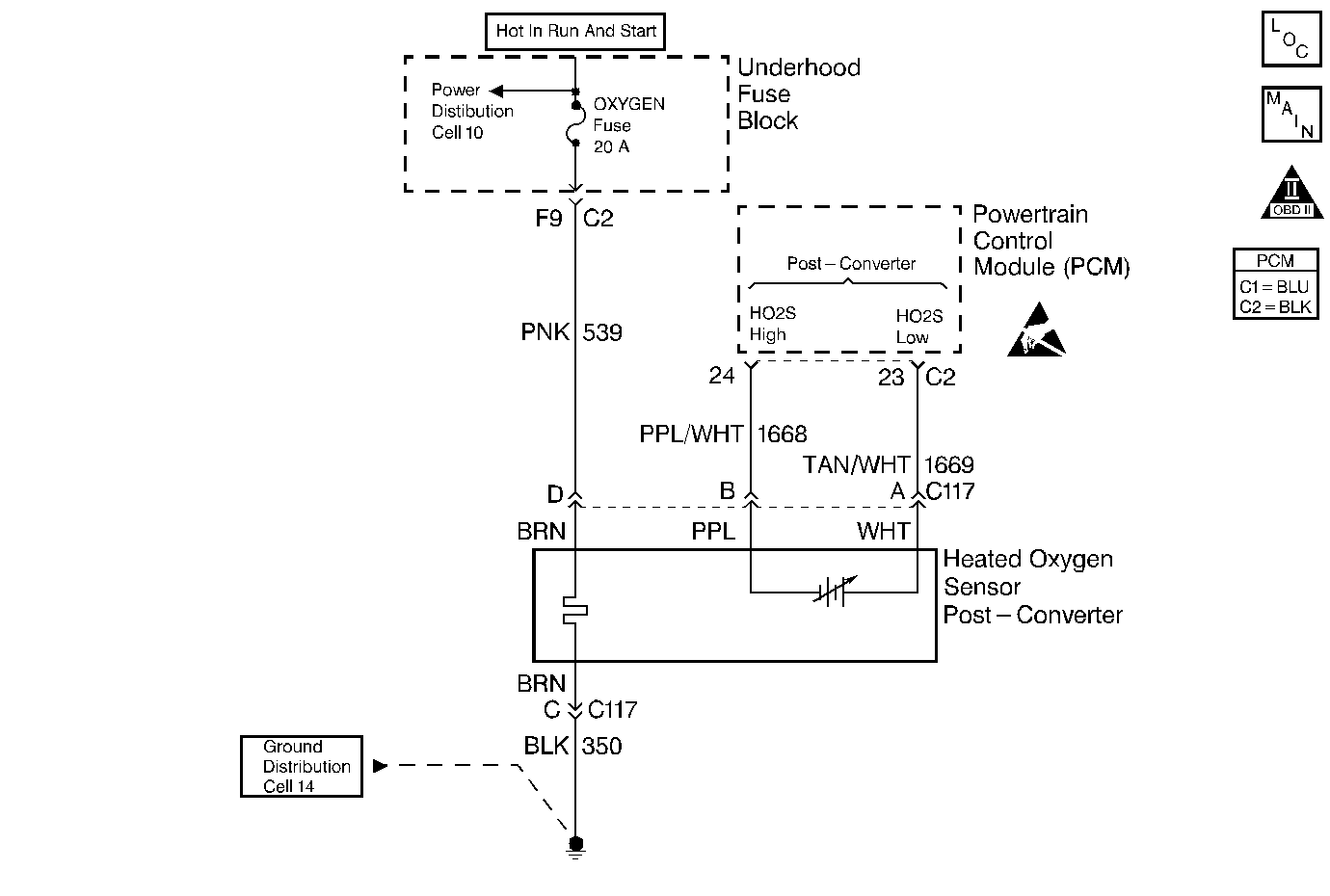
Circuit Description
The heated oxygen sensor (HO2S 2), located in the exhaust stream past the catalytic converter, produces an output signal relative to the oxygen storage capacity of the catalytic converter. The powertrain control module (PCM) can then determine the ability of the catalytic converter to convert the exhaust emissions effectively. The HO2S 2 signal will be far less active than the signal produced by the front oxygen sensor 1 (O2S 1).
Conditions for Running the DTC
| • | No active MAP DTCs |
| • | No active IAT DTCs |
| • | No active ECT DTCs |
| • | No active TP DTCs |
| • | No active fuel trim DTCs |
| • | No active injector control DTCs |
| • | No active misfire DTCs |
| • | No active CKP DTCs |
| • | No active EVAP DTCs |
| • | No active IAC DTCs |
| • | No active PCM memory DTCs |
| • | Air flow is more than 5.5 grams per second |
| • | Engine coolant temperature (ECT) is more than 40°C (104°F) |
| • | The above conditions are met for 140 seconds |
| • | Throttle position (TP) angle is between 5 percent and 50 percent for 4 seconds |
Conditions For Setting The DTC
HO2S 2 remains below 22 mV for 125 seconds.
Action Taken When the DTC Sets
| • | The control module illuminates the malfunction indicator lamp (MIL) if a failure is detected during 2 consecutive key cycles. |
| • | The control module sets the DTC and records the operating conditions at the time the diagnostic failed. The failure information is stored in the scan tools Freeze Frame and Failure Records. |
Conditions for Clearing the MIL/DTC
| • | The control module turns OFF the MIL after 3 consecutive drive trips when the test has Run and Passed |
| • | A history DTC will clear if no fault conditions have been detected for 40 warm-up cycles. A warm up cycle occurs when the coolant temperature has risen 22°C (40°F) from the startup coolant temperature and the engine coolant reaches a temperature that is more than 70°C (158°F) during the same ignition cycle. |
| • | Use a scan tool to clear the DTCs. |
Diagnostic Aids
Whenever the oxygen sensor pigtail wiring, connector, or terminal are damaged, the entire oxygen sensor assembly must be replaced. Do not attempt to repair the wiring, connector, or terminals. In order for the O2S to function properly, the O2S must have a clean air reference. This clean air reference is obtained by way of the oxygen sensor wires. Any attempt to repair the wires, connectors, or terminals may result in the obstruction of the air reference and degrade the oxygen sensors performance.
A rubbed through wire insulation or a wire contacting the exhaust may cause an intermittent.
Check for the following conditions:
| • | The exhaust system -- Inspect the exhaust system for leaks. Check exhaust between the three way catalytic converter and the flange for leaks, corrosion, or for loose or missing hardware and repair as necessary. Refer to Exhaust System Inspection in Engine Exhaust. |
| • | A poor connection or damaged harness -- Inspect the harness for a short to ground in the rear HO2S 2 high circuit, improper mating, or broken locks. Ensure that the HO2S 2 pigtail is not contacting the exhaust. Refer to Testing for Intermittent Conditions and Poor Connections in Wiring Systems. |
| • | An intermittent test -- Observe the rear HO2S 2 on the scan tool while moving related connectors and wiring harness with the key ON. Whenever the fault is induced, the rear HO2S 2 display will change. This may help isolate the location of the malfunction. |
Test Description
The numbers below refer to the step numbers on the diagnostic table:
-
This step determines if DTC P0137 is the result of a hard malfunction or an intermittent condition.
-
It is necessary to jump the HO2S 2 low circuit to ground in order to allow the PCM to display the supplied bias voltage. The PCM and wiring are OK if the voltage is between 0.35 and 0.55 volt .
-
The replacement PCM must be programmed and the Crankshaft Position System Variation Learn procedure must be performed.
Step | Action | Values | Yes | No | ||||
|---|---|---|---|---|---|---|---|---|
1 | Did you perform the Powertrain On-Board Diagnostic (OBD) System Check? | -- | ||||||
2 | With the scan tool, observe the HO2S 2 voltage. Does the HO2S 2 voltage read less than the specified value? | 22 mV | ||||||
Operate the vehicle within the Freeze Frame conditions and the Conditions for Running the DTC as specified in the supporting text. Does the DTC reset? | -- | Go to Diagnostic Aids | ||||||
Caution: Avoid contact with moving parts and hot surfaces while working around a running engine in order to prevent physical injury. Does the HO2S 2 voltage read within the specified range? | 350-550 mV | |||||||
5 |
Did you find and correct the condition? | -- | ||||||
6 |
Did you complete the replacement? | -- | -- | |||||
|
Important:: The replacement PCM must be programmed. Replace the PCM. Refer to Powertrain Control Module Replacement/Programming . Did you complete the replacement? | -- | -- | ||||||
8 |
Does the DTC reset? | -- | System OK |
